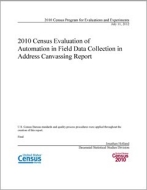2010 Census Evaluation of Automation in Field Data Collection in Address Canvassing Report
2010 Census Evaluation of Automation in Field Data Collection in Address Canvassing Report
Executive Summary
The purpose of this evaluation is to measure operational improvements, efficiencies, and cost savings achieved through increased automation in the 2010 Census Address Canvassing operation. Address Canvassing was the primary method for updating the Census Master Address File during the 2010 Census; where over 100,000 listers verified, updated, or deleted addresses already on the list, added addresses missing from the list, and also validated addresses supplied by participating local governments. The results of this evaluation will provide input for future automation decisions regarding field data collection efforts.
The research questions for this evaluation are:
What was the impact of adding expanded automation to field data collection for Address Canvassing?
- Did automation contribute to operational improvements?
- Did the Census Bureau gain in efficiency?
- Did the Census Bureau see cost savings?
In Census 2000, there was not an Address Canvassing operation. Instead, the Census Bureau conducted Block Canvassing in urban areas and Address Listing in rural areas. Some of the areas covered by Address Canvassing in the 2010 Census were also covered by a List/Enumerate operation in Census 2000 (very rural areas). Block Canvassing and Address Canvassing were dependent listing operations where listers began their work from a predetermined list of units or addresses for each block. Address Listing was an independent listing where listers created their own list of residential units or addresses for each block without aid from a predetermined list.
The first test of automated listing for decennial census operations occurred during the 2004 Census Test. This test included a feasibility study of Global Positioning System (GPS) technology. This GPS study occurred as part of the NonResponse FollowUp test. Subsequently, Address Canvassing automation occurred for the first time in the 2006 Census Test. Due to difficulties implementing the automation in-house, the Census Bureau decided to contract out the development of the automated listing for the 2008 Dress Rehearsal and the 2010 Census. The troubles in the 2006 Census Test were believed to be caused primarily by system integration difficulties. The demand the applications as a group placed on the available Random Access Memory (RAM) of the automation device proved too great. The Field Data Collection Automation contract was awarded to Harris Corporation, which provided the automated listing instrument for both the 2008 Census Dress Rehearsal and 2010 Address Canvassing operation; as well as all of the Information Technology Infrastructure to accomplish these operations. Harris provided a handheld computer with listing software, GPS capability, Time and Expense Reporting, text messaging, and Workload Management capabilities. The handheld computer experienced some performance problems in early testing for large blocks, those with 1,000 or more units. As a result, a contingency plan was developed for the 2010 Address Canvassing operation. Large blocks were listed via slightly modified Demographic Area Address Listing procedures using the Automated Listing and Mapping Instrument.
The 2010 Census Update/Leave operation, where enumerators manually updated the address list and left Census questionnaires for residents to mail back, occurred later and shared many of the same listing activities as Address Canvassing. Both operations systematically updated address lists and maps for given census blocks. Unlike Address Canvassing, however, Update/Leave was a paper operation.
In the 2010 Census operations, Time and Motion studies were conducted for both Address Canvassing and Update/Leave. For the Time and Motion studies, an observer followed a lister to record the duration of specific tasks. These studies can be used to measure efficiency. Personal Digital Assistants (PDAs) were used to record the results in the field. The Time and Motion implementers chose the 2010 geographic sites in the study for both Address Canvassing and Update/Leave to overlap with previously conducted Time and Motion Studies. By controlling for geography, the longitudinal results are more comparable.
To complete this evaluation, it was necessary to compare operations across censuses. When reading this report, please remember the 2010 Address Canvassing operation was not conducted in the same manner as the 2000 Address Listing or Block Canvassing operations. However, these Census 2000 operations provide the best source of comparison for large scale paper listing of addresses. That said, some key differences should be noted:
- Census 2000 Address Listing was an independent listing of addresses. This means listers visited blocks and recorded and map spotted every address from scratch, as opposed to starting with an existing, dependent, list as was done in the 2010 Address Canvassing,
- Map spots were not collected for existing units in Census 2000 Block Canvassing and only every third living quarter was visited,
- Update/Leave occurred after Address Canvassing in the 2010 Census, so Address Canvassing had already improved the listing in those areas.
Others in Series
Publication
Publication
Publication




